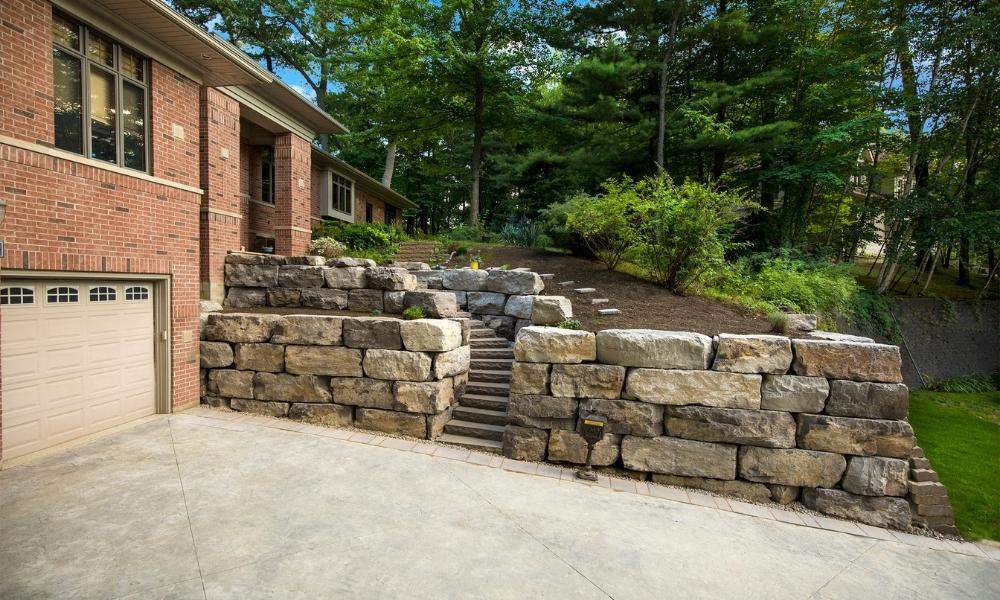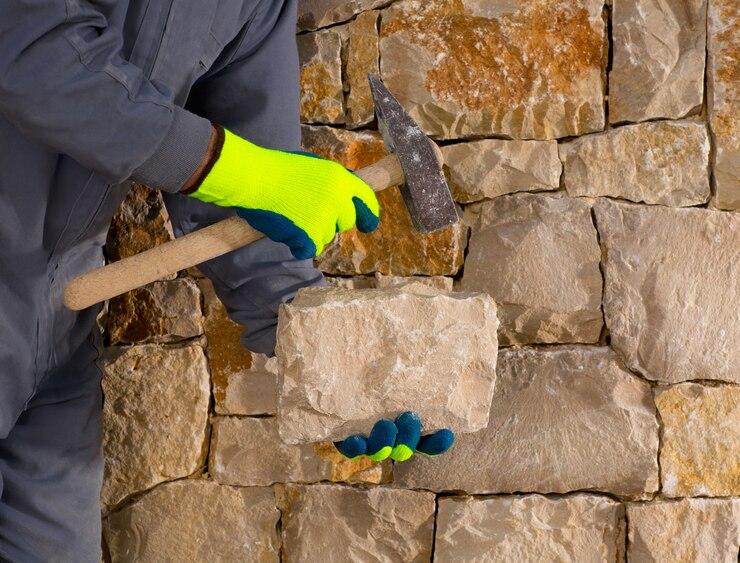Learning
Crafting Strength and Beauty: Your Guide to Armour Stone Retaining Walls

In the realm of landscaping and structural design, the Armour Stone Retaining Wall stands tall, quite literally. This article delves into the intricacies of these sturdy structures that not only serve a practical purpose but also add aesthetic appeal to outdoor spaces.
Understanding the Basics
1. What Are Armour Stones?
Armour stones are large, durable stones used in construction, particularly for retaining walls. These stones are carefully chosen for their size, strength, and ability to withstand environmental factors.
2. The Purpose of Retaining Walls
Before delving into the specifics of Armour Stone Retaining Walls, let’s explore why retaining walls are essential. These structures serve to hold back soil, preventing erosion and ensuring stability in sloped areas.

What kind of stone is best for retaining a wall?
When it comes to choosing the best stone for a retaining wall, several options offer both durability and aesthetic appeal. Here are some popular choices:
- Concrete Blocks:
- Pros: Concrete blocks are versatile, easy to work with, and provide a uniform look. They are also cost-effective.
- Cons: Some may find the appearance less natural compared to other stone options.
- Natural Stone:
- Pros: Options like limestone, sandstone, or granite offer a natural and timeless look. Each stone is unique, providing visual interest.
- Cons: Natural stone can be heavier and may require more skill during the construction process.
- Bricks:
- Pros: Bricks are a classic choice, providing a clean and structured appearance. They are also relatively easy to handle.
- Cons: Limited size options compared to other stones, which can impact the wall’s stability.
- Boulders or Armour Stones:
- Pros: Large stones, such as boulders or specifically designed Armour stones, offer excellent stability and a rustic aesthetic.
- Cons: They can be more challenging to handle and may require professional installation.
- Timber:
- Pros: Timber retaining walls have a warm, natural look. They are often used in more casual or rustic landscaping designs.
- Cons: Timber may be susceptible to decay over time and requires regular maintenance.
- Gabion Walls:
- Pros: These walls use wire baskets filled with stones, creating a unique and modern appearance. They are also flexible and can adapt to the terrain.
- Cons: Installation may be more complex, and the wire baskets require periodic inspection.
Ultimately, the best stone for your retaining wall depends on factors such as budget, the desired aesthetic, and the specific requirements of your landscaping project. It’s crucial to consider both the practical and visual aspects to ensure a successful and long-lasting retaining wall.
The Construction Process
1. Site Preparation
Before the first stone is laid, proper site preparation is essential. Uncover the necessary steps to ensure a stable foundation for your Armour Stone Retaining Wall.
2. Placement Techniques
Building a retaining wall is like solving a giant puzzle. Discover the techniques and considerations involved in placing Armour stones to create a durable and visually pleasing structure.
Mortar vs. No Mortar
To mortar or not to mortar? This section explores the pros and cons of using mortar in Armour Stone Retaining Wall construction, helping you make an informed decision based on your specific needs.

Cost of Armour Stone Retaining Wall
Certainly, the cost of an Armour Stone Retaining Wall in Canada can vary based on factors such as location, project specifics, and materials. Here’s a general overview of the potential costs in Canadian dollars:
- Size of the Wall:
- Small to medium-sized walls (up to 100 square feet): $3,000 to $7,000
- Medium to large-sized walls (100 to 300 square feet): $7,000 to $20,000
- Large walls (300+ square feet): $20,000 and above
- Type and Size of Armour Stones:
- Basic Armour stones: $30 to $50 per square foot
- Specialized or larger stones: $50 to $70 per square foot
- Labour Costs:
- Labour costs in Canada typically range from $30 to $50 per hour per worker. The complexity of the project and the number of workers required will impact overall labour expenses.
- Additional Materials:
- Mortar, drainage materials, and geotextile fabric: $500 to $2,000 depending on the size and requirements of the wall.
- Permits and Regulations:
- Permit costs can vary by municipality. Budgeting $500 to $1,000 for permits is a reasonable estimate.
- Geographic Location:
- Transportation costs for materials can vary based on the project’s proximity to stone suppliers. Local availability may also affect pricing.
- Design Complexity:
- Elaborate designs may increase Laboure costs. Budgeting an additional 10% to 20% for design complexity is advisable.
Note that these figures are approximate and obtaining detailed quotes from local contractors is essential. Consulting with professionals in your specific area will yield a more precise cost assessment tailored to your unique project requirements and local factors.
To provide a rough estimate, the cost of an Armour Stone Retaining Wall can range from $30 to $70 per square foot, considering the factors mentioned above.
Maintaining Your Armour Stone Retaining Wall
1. Regular Inspections
Ensuring the longevity of your retaining wall requires periodic inspections. Learn the signs to look for and how to address potential issues promptly.
2. Cleaning and Preservation
Maintaining the beauty of your Armour Stone Retaining Wall involves more than just structural concerns. Discover effective cleaning and preservation techniques to keep your wall looking pristine.
Hire professional for Armour Stone Retaining Wall

Hiring a professional for your Armour Stone Retaining Wall project is a crucial step to ensure its success. Here’s a guide on hiring the right professional for the job:
- Landscaping Contractors:
- Look for contractors specializing in landscaping and hardscaping projects. They have expertise in designing and constructing outdoor structures, including retaining walls.
- Masonry Contractors:
- Masonry professionals are skilled in working with stones and can provide the expertise needed for proper placement and construction of Armour Stone Retaining Walls.
- General Contractors:
- General contractors with experience in outdoor construction may also handle retaining wall projects. Ensure they have a proven track record with similar installations.
- Check Credentials:
- Verify the contractor’s credentials, including licenses and certifications. A qualified professional should adhere to local regulations and industry standards.
- Experience in Armour Stone Walls:
- Seek professionals with specific experience in designing and building Armour Stone Retaining Walls. Their familiarity with these specific materials is crucial for a successful project.
- Portfolio and References:
- Review the contractor’s portfolio to see past projects, especially those involving retaining walls. Ask for references and contact previous clients to gauge satisfaction.
- Insurance Coverage:
- Ensure the contractor has liability insurance and worker’s compensation coverage. This protects you and the workers in case of accidents or damage during the project.
- Transparent Communication:
- Choose a professional who communicates effectively. They should be willing to discuss the project details, timelines, and potential challenges openly.
- Get Multiple Quotes:
- Obtain quotes from several professionals to compare costs and services. This helps you make an informed decision based on your budget and project requirements.
- Timeline and Availability:
- Inquire about the contractor’s availability and estimated timeline for completing the project. A clear schedule ensures your project stays on track.
- Written Contract:
- Before starting the project, ensure there is a detailed written contract outlining all aspects, including costs, timelines, materials, and warranties.
- Local Knowledge:
- A professional familiar with local soil conditions, climate, and building codes is advantageous. They can navigate potential challenges specific to your area.
By taking these factors into consideration and conducting thorough research, you can confidently choose a professional who not only meets your budget but also delivers a high-quality Armour Stone Retaining Wall tailored to your landscaping needs.
Conclusion
In the world of landscaping, the Armour Stone Retaining Wall stands as a testament to both strength and beauty. Whether you’re seeking structural support or aiming to enhance your outdoor aesthetics, these walls offer a versatile solution.
Frequently Asked Questions (FAQs)
Q1: Can I build an Armour Stone Retaining Wall by myself?
Building a retaining wall requires expertise. While small projects may be manageable, consulting with a professional is recommended for larger structures.
Q2: How long do Armour Stone Retaining Walls last?
With proper construction and maintenance, these walls can last for decades, providing a long-term solution for erosion control.
Q3: Are Armour stones environmentally friendly?
Yes, Armour stones are known for their durability, reducing the need for frequent replacements and minimizing environmental impact.
Q4: Can I use Armour stones for other landscaping purposes?
Absolutely! These stones are versatile and can be employed for various landscaping projects, adding both functionality and aesthetic appeal.
Learning
First-Time Buyer’s Guide to the UK Property Market

Entering the UK property market as a first-time buyer can feel both exciting and daunting. The process is filled with potential pitfalls and complex decisions, but with the right guidance, it can be navigated smoothly. The estate agents in Yorkshire demystify the journey from the initial decision to buy a home to the moment you step over the threshold of your new property.
Understanding Your Financial Position
The first and perhaps most crucial step in the home-buying process is understanding your financial situation. This includes assessing your savings, income, and current debts. Here’s how you can prepare:
1. Deposit: Generally, you’ll need at least 5% of the property price as a deposit, though aiming for 10% or more can provide better mortgage rates.
2. Income and Expenses: Use a budget planner to assess your monthly income against your expenses. This will help you understand how much you can afford in monthly mortgage repayments.
3. Credit Score: Lenders will evaluate your credit score to determine your mortgage eligibility. So it’s important to have a good credit score, and you should work on it if required.
4. Mortgage Options: Speak to a mortgage advisor to understand different types of mortgages, such as fixed-rate, variable-rate, and help-to-buy schemes.
Getting a Mortgage Agreement in Principle
A Mortgage Agreement in Principle (AIP) is a statement from a lender indicating how much they’ll likely lend you. You will be a more attractive buyer with an AIP as it shows sellers you’re serious and financially prepared.
Deciding What You Want
Before you start viewing properties, it’s essential to know what you’re looking for. Consider the following factors:
1. Location: Proximity to work, schools, public transport, and amenities are key. Research neighbourhoods to find the best fit for your lifestyle.
2. Property Type: Decide whether you want a flat, terraced house, semi-detached, or detached property. Each has its pros and cons.
3. Must-Haves: Make a list of non-negotiables, such as the number of bedrooms, garden size, and parking facilities.
4. Future Proofing: Consider your future needs. Are you planning to start a family? Do you need space for a home office?
Starting the Property Search
With a clear idea of what you’re looking for, you can begin your property search. Here are some tips:
1. Use Online Portals: Websites like Rightmove, Zoopla, and OnTheMarket are excellent starting points. Set up alerts to get notified of new listings that meet your criteria.
2. Visit Estate Agents: Register with local estate agents who can provide insights into the market and inform you of new properties before they’re listed online.
3. Attend Viewings: Don’t rush this part. Visit several properties to get a feel for what’s available in your price range.
Making an Offer
Once you find a property you love, it’s time to make an offer. Here’s how to approach it:
1. Research: Check the selling prices of similar properties in the area to gauge a fair offer.
2. Negotiate: Don’t be afraid to negotiate. The starting point is most usually the asking price.
3. Conditions: You might include conditions in your offer, such as the inclusion of certain fixtures or a specific moving date.
The Legal Process
If your offer is accepted, the legal process begins. You’ll need a solicitor or licensed conveyancer to handle the legalities. Here’s what to expect:
1. Conveyancing: This is the legal transfer of property ownership. Your solicitor will handle this, including conducting searches, dealing with the Land Registry, and transferring the funds.
2. Surveys and Inspections: Arrange for a property survey to check for structural issues. There are different types of surveys, from basic condition reports to full structural surveys.
3. Mortgage Finalisation: Once the survey is complete and satisfactory, your mortgage can be finalised.
4. Exchange of Contracts: This is when the sale becomes legally binding. You’ll pay your deposit at this stage.
5. Completion: On the agreed completion date, the remaining money is transferred, and you receive the keys to your new home.
Moving In
Moving day can be hectic, but planning can ease the stress:
1. Hire a Removal Company: Book a reliable removal company well in advance. Discover the best deals by getting quotes from multiple companies.
2. Pack Strategically: Label your boxes by room and keep essential items accessible.
3. Notify Utilities and Change Address: Inform your utility providers of your move date and update your address with banks, the DVLA, and other important institutions.
Settling In
Get settled. Introduce yourself to the neighbours, familiarise yourself with the local area, and really start to make the place your own.
Here are a few final tips:
1. Safety Checks: Make sure that your smoke alarms and carbon monoxide detectors are working, and make sure that you know where the gas and electricity meters are located.
2. Maintenance Plan: Keep a record of the smooth functioning of your new home with a maintenance schedule, complete with regular checks and seasonal tasks.
3. Personal Touches: Add personal touches to make the space feel like home. This can be from putting up family photos or redoing the decoration in your rooms.
Conclusion
Buying your very first home in the UK is most definitely a milestone, difficult and full of challenges but rewarding in the end. Such a philosophy guides you in understanding finances and knowing what you want to achieve from detailed research, and seeking professional advice that confidently helps you navigate the property market. Yes, the journey may have its hurdles, but in the end—owning your own home—the reward will be worth the effort. Welcome to your new chapter!
SEE ALSO: Conquer the Chaos: Hacks to Clean Your Home in Half the Time
Learning
5 Health Benefits of Regular Pedicures

There’s nothing quite like a pedicure to keep your feet looking and feeling their best, but did you know that pedicures do more than simply enhance the appearance of your feet? Many people don’t realize that regular pedicures can come with a wide range of health benefits that can promote the well-being of your feet, so here are some ways that your routine pedicure keeps both your toenails and feet in the best condition possible!
Smoother Skin
One of the biggest misconceptions about pedicures is that they only cater to and look after your toenails. While you’ll definitely be leaving each session with a fresh coat of nail polish, your pedicure can also do wonders for the health of your skin. Aside from trimming and shaping your nails and cuticles, you’ll notice that your nail technician also dedicates a few steps to the skin of your feet.
After inspecting your feet and looking for any issues or imperfections that may need to be addressed, your technician will work on an exfoliating scrub to remove any dead skin cells. This step may also be aided by a foot file, which can be used to buff away any calluses and other problem areas manually.
Softer Skin
After your nail technician addresses all the problem areas of your feet and removes any unwanted dead skin cells, he or she will often massage in a moisturizing product, such as lotion, cream, or butter, to ensure that your skin is properly moisturized. These products contain skin-loving ingredients that will ensure that your feet have everything they need to look and feel their best so that you can walk out of your pedicure with a renewed sense of confidence.
Healthier Nails
After your pedicure session, your nails will not only look better due to the fresh coat of nail polish, but they’ll also be healthier and stronger. This is because your nail technician takes their time to ensure that your nails are properly looked after through steps that include deep cleaning, nail trimming, nail filing, and cuticle care. All of these things work together to prevent issues like ingrown nails from occurring, all the while improving the appearance of your nails.
Increased Blood Circulation
While the specific steps included in your pedicure will depend on the beauty salon, most pedicures will have a massage step somewhere in the mix. One of the often overlooked benefits of these massages is the increased blood circulation, which can deliver more nutrients and oxygen to your feet and nails, promoting their health and appearance. Aside from that, better blood flow means reduced tension and soreness, as well as better distributed heat throughout your body.
Reduced Infections
A significant amount of dirt and bacteria can build up on your feet without you even realizing it, but pedicures can be a great way to prevent these from happening in the first place. The exfoliation step of a pedicure removes dead skin cells as well as all the debris that may have accumulated underneath, and the deep cleaning of your toenails and cuticles also gets rid of any impurities that may have slipped beneath them, which can stop infections from happening.
These are some of the many health benefits that you can look forward to at your next pedicure appointment. However, it’s worth noting that you need to book regular sessions to truly reap all the rewards. This can be difficult, especially when you don’t feel like driving to your nearest nail salon after a long day, but the good news is that you can enjoy the salon experience in the comfort of your own home with a home pedicure service.
Learning
Commercial Boiler Installation Services London

For businesses in the bustling city of London, having a reliable heating system is crucial. Whether you’re opening a new office, expanding your current premises, or simply upgrading an outdated system, commercial boiler installation services for businesses in London are essential to ensure your operations run smoothly and efficiently. Proper installation and maintenance of commercial boilers can make a significant difference in energy efficiency, cost savings, and the overall comfort of your workspace.
The Importance of Professional Installation
When it comes to installing a commercial boiler, professional expertise is paramount. Here’s why:
- Efficiency and Performance: Professional installation ensures that your boiler operates at peak efficiency, reducing energy consumption and lowering utility bills. A well-installed boiler can effectively meet the heating demands of your business without unnecessary energy waste.
- Safety: Commercial boilers are complex systems that require precise installation to operate safely. Professional installers adhere to stringent safety standards and regulations, minimizing the risk of accidents and ensuring the safety of your employees and premises.
- Compliance with Regulations: Commercial properties are subject to various building codes and regulations. Professional installers are well-versed in these requirements and ensure that your boiler system complies with all local laws and standards.
- Longevity and Reliability: Proper installation is critical to the longevity and reliability of your boiler. A professional installation can prevent common issues such as leaks, pressure problems, and system failures, ensuring that your boiler runs smoothly for years to come.
Key Considerations for Commercial Boiler Installation
When planning for a commercial boiler installation, several factors need to be considered:
- Type of Boiler: The type of boiler you choose will depend on your business’s specific needs. Options include gas boilers, oil boilers, and electric boilers, each with its own set of advantages. Consulting with a professional can help you determine the best choice for your business.
- Sizing and Capacity: The boiler’s size and capacity must match the heating demands of your commercial space. An undersized boiler will struggle to meet your needs, while an oversized one will lead to inefficiencies and higher costs.
- Location: The placement of your boiler affects its efficiency and accessibility for maintenance. Professional installers can help you choose the optimal location for your boiler.
- Integration with Existing Systems: If you’re upgrading or replacing an existing boiler, it’s essential to ensure compatibility with your current heating system. Professional installers can seamlessly integrate the new boiler with your existing setup.
Choosing the Right Installation Service

Selecting the right installation service provider is crucial to the success of your boiler installation project. Consider the following when making your choice:
- Experience and Expertise: Look for a provider with a proven track record in commercial boiler installations. Experienced installers can handle the complexities of commercial systems and provide high-quality workmanship.
- Reputation: Check reviews and testimonials from previous clients to gauge the provider’s reliability and customer satisfaction.
- Comprehensive Services: Choose a provider that offers a full range of services, including installation, maintenance, and repair. This ensures that all your boiler needs are met by a single, trusted source.
In London, ROWLEN is a reputable name known for delivering top-notch commercial boiler installation services. Their team of experts is dedicated to providing efficient, safe, and compliant installations tailored to the unique needs of businesses.
Conclusion
Investing in professional commercial boiler installation services for businesses in London is essential for ensuring efficiency, safety, and long-term reliability. By choosing an experienced and reputable service provider like ROWLEN, you can rest assured that your heating system will be installed correctly and maintained to the highest standards. Proper installation not only enhances the performance of your boiler but also contributes to the overall comfort and productivity of your business environment.
SEE ALSO:
-

 News3 years ago
News3 years agoLet’s Know About Ultra High Net Worth Individual
-
Entertainment2 years ago
Mabelle Prior: The Voice of Hope, Resilience, and Diversity Inspiring Generations
-

 Health3 years ago
Health3 years agoHow Much Ivermectin Should You Take?
-

 Tech2 years ago
Tech2 years agoTop Forex Brokers of 2023: Reviews and Analysis for Successful Trading
-

 Lifestyles2 years ago
Lifestyles2 years agoAries Soulmate Signs
-

 Movies2 years ago
Movies2 years agoWhat Should I Do If Disney Plus Keeps Logging Me Out of TV?
-

 Health3 years ago
Health3 years agoCan I Buy Ivermectin Without A Prescription in the USA?
-

 Learning2 years ago
Learning2 years agoVirtual Numbers: What Are They For?
